
Aarhus is the second-largest city in Denmark and the seat of Aarhus Municipality. It is located on the eastern shore of Jutland in the Kattegat sea and approximately 187 kilometres (116 mi) northwest of Copenhagen.

A meteorite is a solid piece of debris from an object, such as a comet, asteroid, or meteoroid, that originates in outer space and survives its passage through the atmosphere to reach the surface of a planet or moon. When the original object enters the atmosphere, various factors such as friction, pressure, and chemical interactions with the atmospheric gases cause it to heat up and radiate energy. It then becomes a meteor and forms a fireball, also known as a shooting star; astronomers call the brightest examples "bolides". Once it settles on the larger body's surface, the meteor becomes a meteorite. Meteorites vary greatly in size. For geologists, a bolide is a meteorite large enough to create an impact crater.

A chondrite is a stony (non-metallic) meteorite that has not been modified, by either melting or differentiation of the parent body. They are formed when various types of dust and small grains in the early Solar System accreted to form primitive asteroids. Some such bodies that are captured in the planet's gravity well become the most common type of meteorite by arriving on a trajectory toward the planet's surface. Estimates for their contribution to the total meteorite population vary between 85.7% and 86.2%.

Hebe is a large main-belt asteroid, containing around 0.5% of the mass of the belt. However, due to its apparently high bulk density, Hebe does not rank among the top twenty asteroids by volume. This high bulk density suggests an extremely solid body that has not been impacted by collisions, which is not typical of asteroids of its size – they tend to be loosely-bound rubble piles.
The Morokweng impact structure is an impact structure buried beneath the Kalahari Desert near the town of Morokweng in South Africa's North West province, close to the border with Botswana.
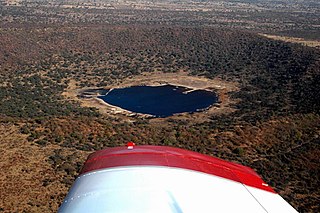
Tswaing is an impact crater enclosed by a 1,946 ha nature reserve, situated in northern Gauteng province, South Africa. The crater and reserve are situated on a base of ancient granite of the Bushveld Igneous Complex, some 40 km to the north-northwest of Pretoria. This astrobleme is 1.13 km in diameter and 100 m deep and its age is estimated to be 220,000 ± 52,000 years (Pleistocene). The impactor is believed to have been a chondrite or stony meteorite some 30 to 50 m in diameter that was vaporised during the impact event. Morokweng impact structure, another South African crater of chondrite origin, lies north-west of Vryburg. Since 1996 it falls under the auspices of Ditsong Museums of South Africa.

The H type ordinary chondrites are the most common type of meteorite, accounting for approximately 40% of all those catalogued, 46% of the ordinary chondrites, and 44% of all chondrites. The ordinary chondrites are thought to have originated from three parent asteroids, whose fragments make up the H chondrite, L chondrite and LL chondrite groups respectively.

The ordinary chondrites are a class of stony chondritic meteorites. They are by far the most numerous group, comprising 87% of all finds. Hence, they have been dubbed "ordinary". The ordinary chondrites are thought to have originated from three parent asteroids, with the fragments making up the H chondrite, L chondrite and LL chondrite groups respectively.

The L type ordinary chondrites are the second most common group of meteorites, accounting for approximately 35% of all those catalogued, and 40% of the ordinary chondrites. The ordinary chondrites are thought to have originated from three parent asteroids, with the fragments making up the H chondrite, L chondrite and LL chondrite groups respectively.
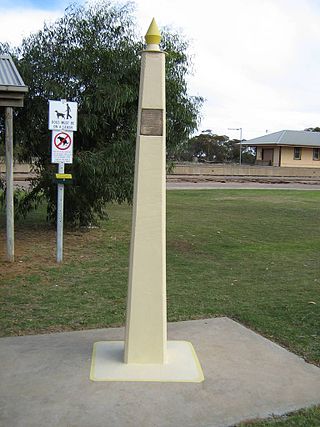
The Karoonda meteorite is a meteorite that fell to earth on 25 November 1930 at 10:53 pm near the South Australian town of Karoonda. It is of a rare composition, being carbonaceous chondrite, and is also rare in that it was found so soon after its landing. Several fragments are now held in the South Australian Museum in Adelaide.
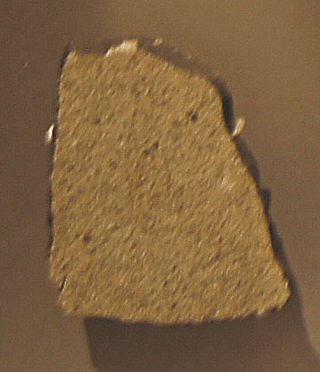
The Sylacauga meteorite fell on November 30, 1954, at 12:46 local time in Oak Grove, Alabama, near Sylacauga, in the United States. It is also commonly called the Hodges meteorite because a fragment of it struck Ann Elizabeth Fowler Hodges (1920–1972).

The Ensisheim meteorite is a stony meteorite that fell on November 7, 1492 in a wheat field outside the walled town of Ensisheim in then Alsace, Further Germany. The meteorite can still be seen in Ensisheim's museum, the sixteenth-century Musée de la Régence. It is the oldest stony European meteorite fall from which there is still some meteoritic material preserved.
Bovedy is a meteorite that fell in the area of Bovedy, Northern Ireland, on 25 April 1969. After entering the atmosphere over the Bristol Channel, it traversed Wales and the Irish Sea before landing near Limavady.

Riis Skov is a forest and park in Århus, Denmark. It is located south of the district of Risskov, along the Bay of Aarhus.
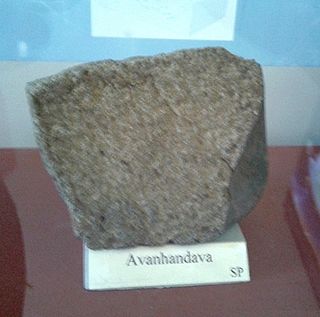
Avanhandava is an H chondrite meteorite that fell to earth in 1952 in São Paulo, Brazil.
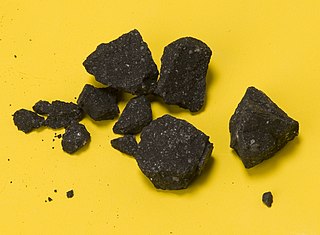
The Sutter's Mill meteorite is a carbonaceous chondrite which entered the Earth's atmosphere and broke up at about 07:51 Pacific Time on April 22, 2012, with fragments landing in the United States. The name comes from Sutter's Mill, a California Gold Rush site, near which some pieces were recovered. Meteor astronomer Peter Jenniskens assigned Sutter's Mill (SM) numbers to each meteorite, with the documented find location preserving information about where a given meteorite was located in the impacting meteoroid. As of May 2014, 79 fragments had been publicly documented with a find location. The largest (SM53) weighs 205 grams (7.2 oz), and the second largest (SM50) weighs 42 grams (1.5 oz).

The Novato meteorite is an ordinary chondrite which entered the earth's atmosphere and broke up over Northern California at 19:44 Pacific Time on 17 October 2012. The falling bolide created a bright fireball and sonic booms and fragmented into smaller pieces as the intense friction of passing through the atmosphere heated it and absorbed its kinetic energy. The meteoroid was about 35 centimeters (14 in) across.
This is a glossary of terms used in meteoritics, the science of meteorites.
Science Museums, Aarhus, founded 1 January 2008, is an umbrella organization comprising the Steno Museum, the greenhouses at Aarhus Botanical Gardens, the Ole Rømer Observatory and a herbarium in Aarhus, Denmark. The Science Museums works as an independent institution under the Science and Technology department of Aarhus University.

The Winchcombe meteorite is a carbonaceous chondrite meteorite that was observed entering the Earth's atmosphere as a fluorescent green fireball over Gloucestershire, England, at 21:54 hours on 28 February 2021. Due to a public appeal, fragments were quickly recovered from the village of Winchcombe, enabling it to be collected for analysis before becoming degraded.














